I keep reading in the news that we’re in the middle of the second wave of this tough flu season. If you’re unlucky enough to have caught the flu, I wish you a speedy recovery! I got the flu earlier this year, and had terrible head and chest congestion. I was looking for natural remedies to ease my discomfort, and created this natural decongestant & cough relieving cream.
Disclaimer: This post contains affiliate links. See my Disclosure Policy for more information.
In addition to using this natural decongestant & cough relieving cream, which is aimed to have similar results to using Vicks Vaporub, I also used my natural nasal decongestant spray. And lots of tissues… While none of these things are remedies or cures, they did help to loosen the congestion and alleviate my discomfort a bit.
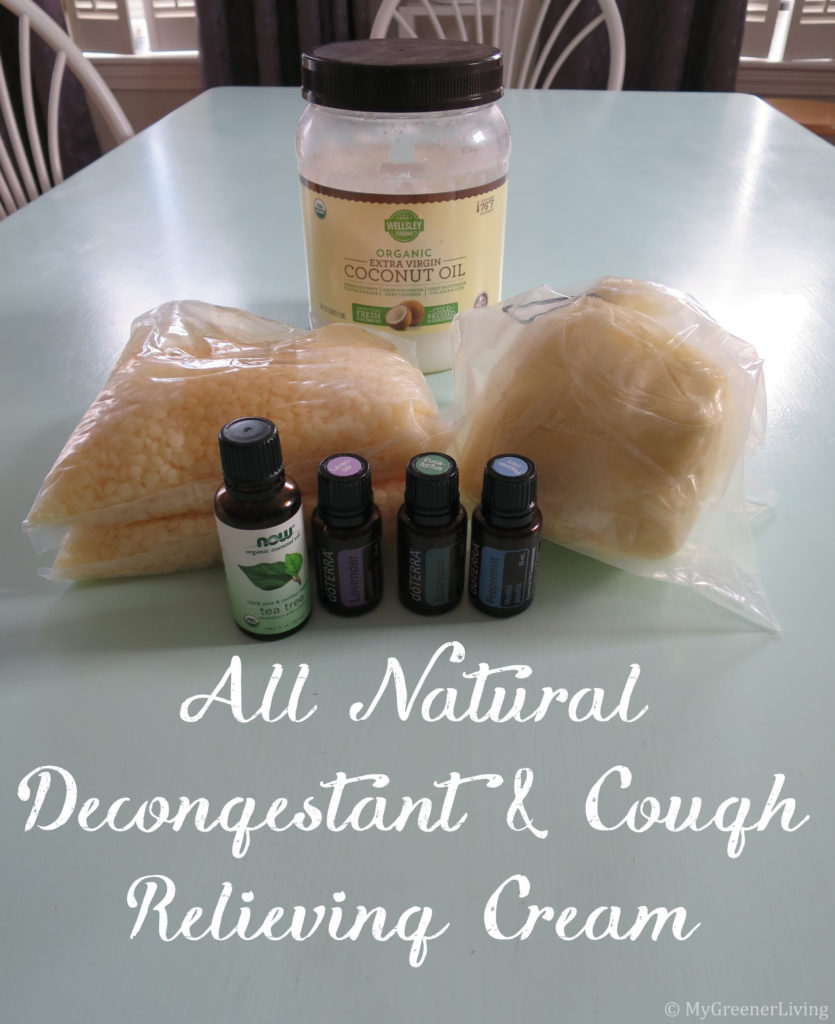
Ingredient selection
I selected the ingredients in this natural decongestant and cough reliving recipe based on what ingredients I know are safe for my skin, properties of the ingredients, and what ingredients I had on hand. I looked through several different recipes for topical natural decongestants & cough relief and picked what I thought would work best for me. This recipe can be tailored to meet different needs and preferences. I plan to always keep the same ratio carrier “oils” (in this recipe, the coconut oil, shea butter, and beeswax) to essential oils. This recipe is about 2% essential oil.
I mixed this natural decongestant & cough relief cream for my personal, adult use. Some of the oils that I selected are not safe for babies or small children – peppermint and eucalyptus. Mommypotamus has a great post about which oils are safe for children.
- Coconut Oil – great overall moisturizer, antibacterial, liquid above 76°F (24°C), fairly high comedogenic, great EWG rating (1)
- Shea Butter – great moisturizer, solid at room temperature, non-cogmedogenic, great EWG rating (1)
- Beeswax – seals in moisture to protect skin, antimicrobial, moderately low comedogenic, great EWG rating (1)
- Eucalyptus essential oil – Used topically and aromatically to ease congestion by helping to dissolve mucus; helps to alleviate coughing due to dissolving mucus*
- Peppermint essential oil – Used topically and aromatically to ease congestion by helping to dissolve mucus; also may help alleviate coughing*
- Tea Tree essential oil (melaleuca)- Used topically and aromatically to help alleviate coughing, and dissolve mucus;* antibacterial, anti-fungal, antiviral
- Lavender essential oil – Used aromatically and topically for calming, soothing, relaxing*
*From Modern Essentials: A Contemporary Guide to the Therapeutic Use of Essential Oils, sixth edition.
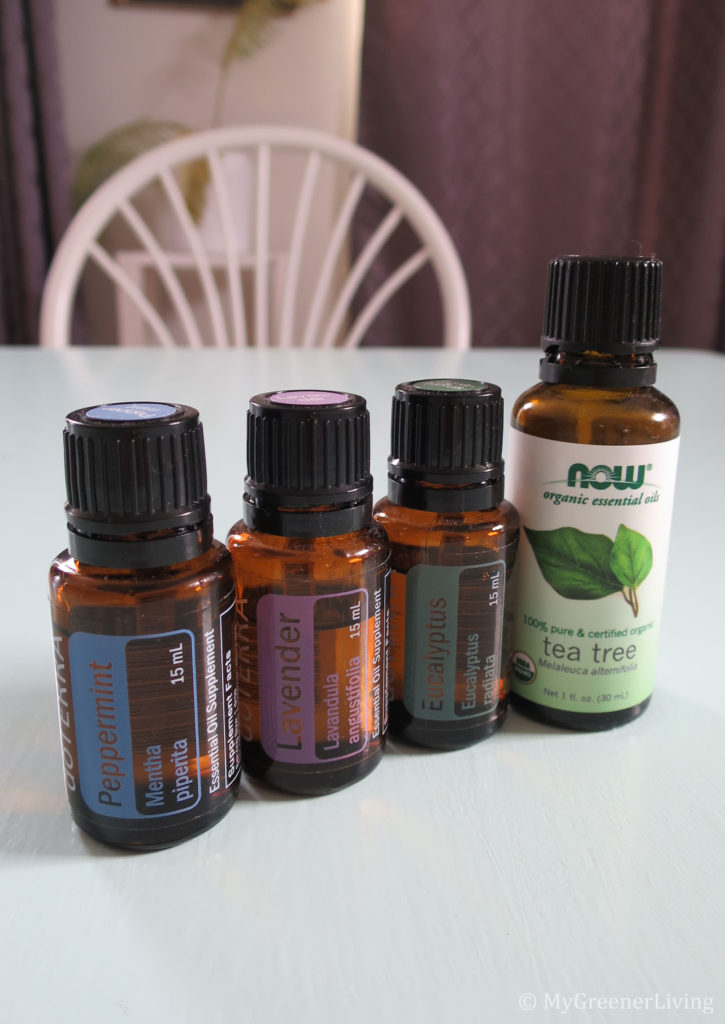
Natural Decongestant & Cough Relieving Cream Recipe – 2% essential oil
I made a small batch – a little over 1 fluid ounce – since a little goes a long way with essential oils. Plus, I had a cute little 2 oz glass jar that I wanted to use 🙂 This recipe can easily be scaled up – just double or triple the amount of each ingredient – just be sure to use the same scaling factor (x2, x3, etc.) for each ingredient in each batch. To calculate different essential oil percentages (dilutions), Mommypotamus put together this great chart for reference.
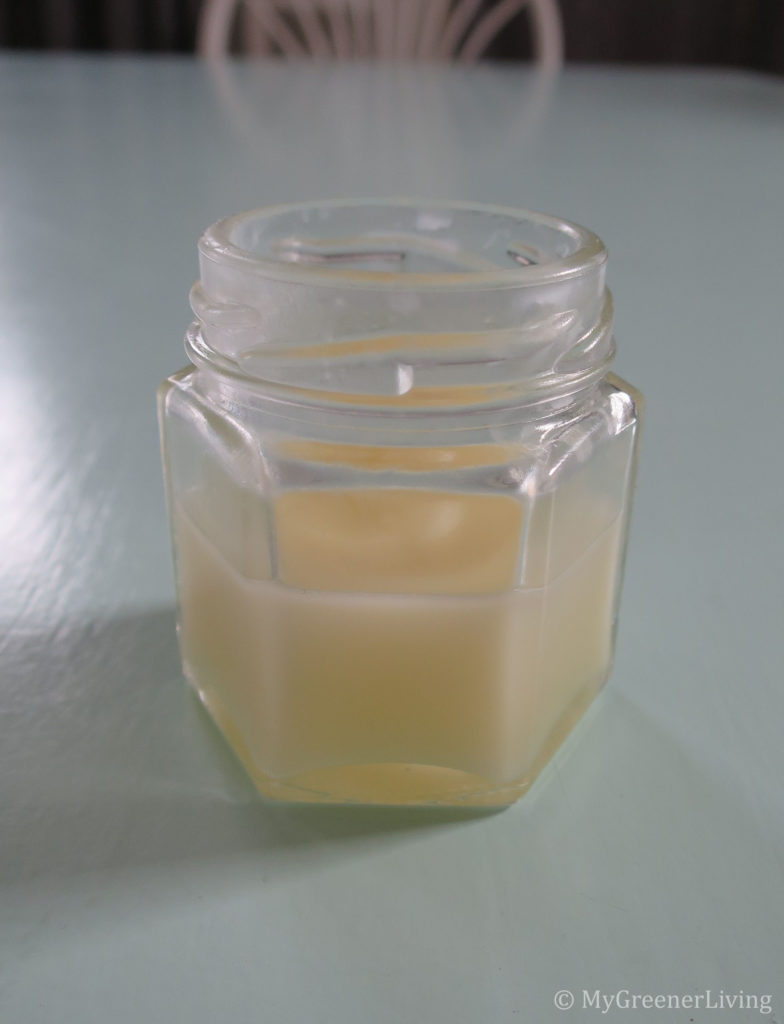
Since beeswax comes in all different shapes, and solid coconut oil and shea butter can be messy to try to measure precisely with measuring spoons, I always weigh my cosmetic recipes. My favorite kitchen scale is from American Weigh Scales, but since I haven’t replaced mine after dropping something on it and damaging the display, I use my Escali scale which only measures to 1 gram precision, but works well enough for my recipes. Additionally, I like weighing vs. volume measuring when dealing with essential oils because it is more accurate so I can more easily ensure that I have the dilution of essential oils that I want.
As for the % essential oil, I melted my coconut oil, shea butter, and beeswax and found that I had just over 1 fluid ounce (or 6 teaspoons). I used this carrier oil amount to determine how much essential oil to add.
Ingredients
- 10 grams coconut oil
- 4 grams shea butter
- 2.5 grams beeswax
- 3 drops tea tree essential oil
- 3 drops lavender essential oil
- 3 drops peppermint essential oil
- 3 drops eucalyptus essential oil

Instructions
- In a microwave-safe glass bowl, measure the beeswax, shea butter, and coconut oil. Microwave on 50% power for 30 seconds, stir (I use a toothpick or clean popsicle stick), microwave another 30 seconds, stir, and repeat until the mixture is completely melted. Alternately, I could have used a double-boiler, but I chose to measure directly into the jar that I would use to store the cream, and melting in the microwave was easier and required basically no clean-up.
- To the melted coconut oil-shea butter-beeswax, add 3 drops each tea tree, lavender, peppermint, and eucalyptus essential oils. Using the toothpick or popsicle stick, I mix well to uniformly distribute the essential oils throughout the mixture.
- I allow the mixture to cool completely before using to avoid burns. I wanted to use this decongestant soon, so I put the glass jar with the mixture in the refrigerator for about 45 minutes. I could have allowed it to cool at room temperature overnight.
How I use the natural decongestant & cough relieving cream
I use this natural decongestant & cough relieving cream topically, much as one would use Vicks Vaporub. I applied it to my chest, soles of my feet, and, since I made this with a low dilution of essential oils, on my face – under and around my nose, and on my forehead. As an added bonus, the base ingredients of this cream are in my solid lotion bars, so they doubled as a heavy moisturizer for my chapped nose.
This is a fairly low dilution recipe at just under 2%, so I do not hesitate to use it fairly frequently: 4-6 times per day.
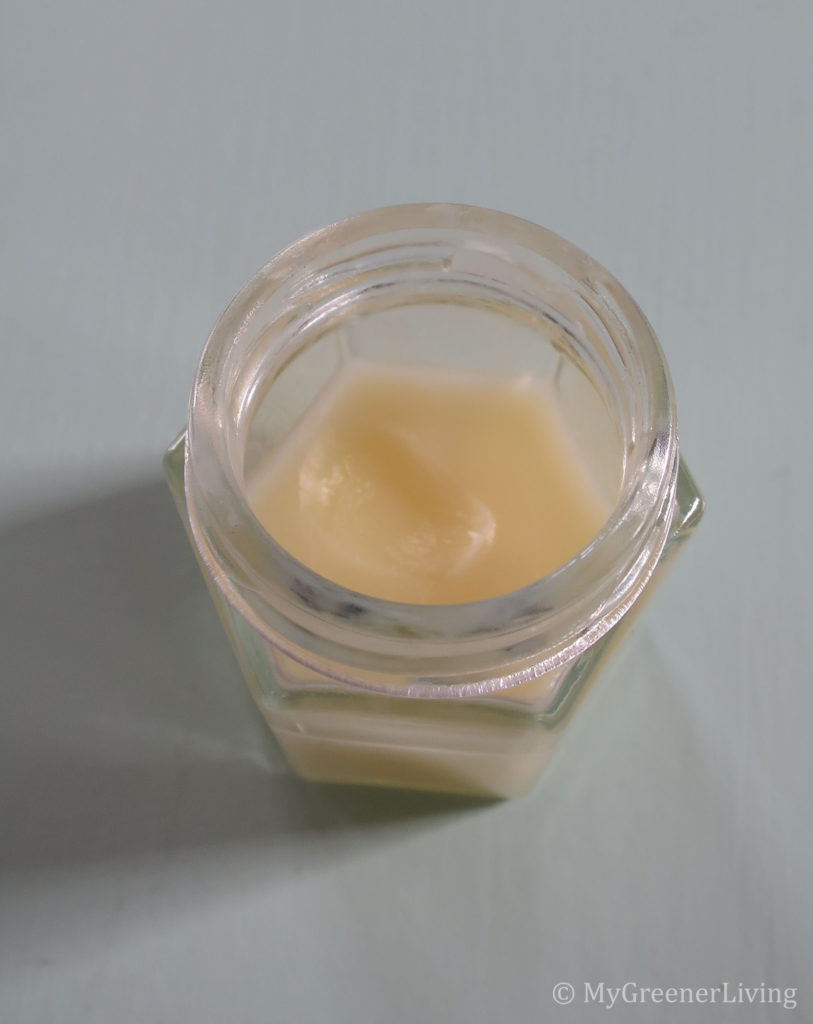
Why I make my own decongestant & cough relieving cream
I am often asked why I make my own products when I could just buy something that was created for the same purpose. My answer for this decongestant & cough reliving cream is the same as for most products: primarily the ingredients, and also cost. When I make my own product, I know exactly what is in it, and I can create a recipe using only ingredients that I know work well on my body and do not cause adverse reactions.
The alternative to my natural decongestant & cough reliving cream contains a couple ingredients that I avoid. Per the manufacturer, the full ingredient list for the children’s version of Vick’s Vaporub is:
Active Ingredients: Camphor (synthetic) 4.8% – (Cough suppressant and topical analgesic); Eucalyptus oil 1.2% – (Cough suppressant); Menthol 2.6% – (Cough suppressant and topical analgesic)
Inactive Ingredients: Cedarleaf oil, fragrance, nutmeg oil, petrolatum, thymol, turpentine oil
Petrolatum is petroleum based (oil) and rated as moderate concern by the EWG. There is also high concern for contamination with PAHS, which is likely carcinogenic (cancer-causing) and banned from cosmetics. Turpentine oil is paint thinner, but also considered by some to be medicinal as a pain reliever, and an overall health concern according to the EWG. “Fragrance” can be a number of more or less harmful (or in my case, skin allergy causing) things. I choose to avoid putting these things on or in my body, so I make my own version!
It also can be a lot less expense to make, especially when I make a lot of products and know that I will use up all of the ingredients individual ingredients between my recipes.
Cost
Coconut oil – $16.04 for 54oz at BJ’s Wholesale Club. 10grams x (1oz/27.02 grams) x ($16.04/54oz) = $0.110 (Available on Amazon for a bit more. Still a good deal!)
Shea butter – $11.50 for 1lb on Amazon. 4grams x (1lb/453.592gram) x ($11.50/lb)=$0.101
Beeswax – $18.95 for 2 lb on Amazon. 2.5grams x (1lb/453.592gram) x ($18.95/2lb)=$0.052
Tea Tree Oil – $10.64 per fl oz on Amazon. 600 drops oil per ounce. 3 drops x (1 fl oz/600 drops) x ($10.64/fl oz) = $0.053
Eucalyptus Oil – $8.69 per fl oz on Amazon. 600 drops oil per ounce. 3 drops x (1 fl oz/600 drops) x ($8.69/fl oz) =$0.043
Peppermint Oil – $11.82 per fl oz on Amazon. 600 drops oil per ounce. 3 drops x (1 fl oz/600 drops) x ($11.82/fl oz)=$0.059
Lavender Oil – $14.64 per fl oz on Amazon. 600 drops oil per ounce. 3 drops x (1 fl oz/600 drops) x ($14.64/fl oz)=$0.073
2 oz glass jar – $20.99 for 24 on Amazon. $20.99/24=$0.875 per jar
Total cost for 17 grams (0.6 oz) cream: $0.49, which equates to $1.44 for 50 grams (1.76 oz)
Total cost 0.6 oz cream in jar: $1.34
For comparison, Vick’s VapoRub Children sells on Amazon, $4.97 for 50 grams (1.76 oz), which is $4.97/$1.44=3.45 times the cost of my homemade decongestant.
Note about essential oils – though I pictured DoTerra essential oils, I now buy Now Organic Essential Oils whenever I can find them. My experience with the Now brand has been good, and I have never had an adverse reaction to any of their oils, organic or conventional. I purchase organic to avoid pesticides which I have concern may irritate my sensitive skin. I have not had any adverse reactions to DoTerra, but I can’t find organic versions and their oils are more pricey.
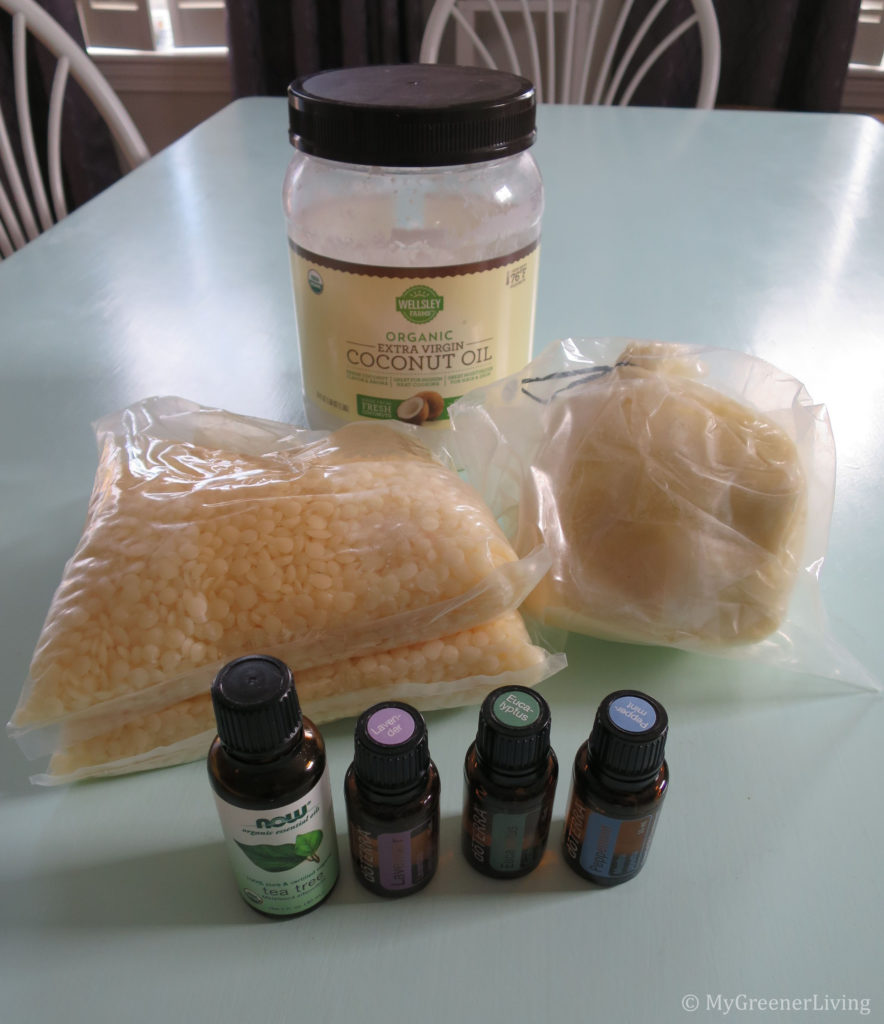
My notes about the Flu
- Yes, I got the flu shot this year and yes, I still got the flu. However, I will continue to get the flu shot each year. I believe that the flu was less severe because I got the flu shot and my body had already created antibodies to some flu strains.
- I did not know until this year, but it IS possible to get the flu and not have a fever. While it can be difficult to tell the difference between a cold and flu, I previously thought if I didn’t have a fever it must be a cold. However, this time I was hit hard, had very little energy, and could not fight through to function as I need to in a normal day. Which led me to research a bit, and discover that I could in fact have the flu without a fever.
Do you have any natural remedies to make dealing with colds and the flu more bearable? Please share in the comments below!
